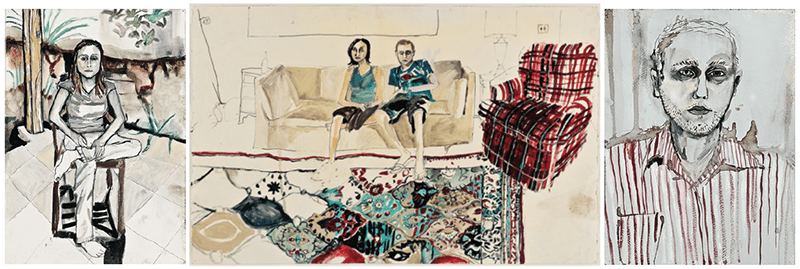Raffi Kalenderian: Beyond the temporal and spatial limits

From left to right:
Alice, 2006
Frankie and Tiarra, 2005
Self-Portrait (Three-Day-Beard), 2006;
Oil on canvas
For Raffi Kalenderian, portraying a person provides him various options and directions to choose from: observation versus distortion, fact versus fiction, investigating the psychology of the sitter versus keeping an emotional distance.
In Kalenderian’s body of work, space bends, brush marks dissolve images, and darkness is built-up in layers, creating moments where painting’s mechanisms are the real subject. Recognizably throughout his artistic production, his subjects are friends and family, thus individuals depicted inhabiting their own singular existence. In his portraits, the boundaries between figure and background are blurred in such a way that poets, playwrights, starlets and painters become isolated characters evoking an introspective sensibility.
Most of his protagonists are depicted in full-length portraits in domestic settings, such as Angie (2005), Rhys (With Basketball) (2005), Elliot (Red Beard) (2005), Alice (2006), Louis (On my bed) (2006), Matt (Playing guitar) (2006), Frankie and Tiarra (2005), and Lili Reclining (2006). The majority of Kalenderian’s artworks hold the sitter’s first names only as title. In these artworks that are part of Adrastus Collection, the shimmering colors, attractively decorated private rooms and lush front gardens offer glimpses of household interiors or studios.
Painted with rather crude brush strokes, the people in his paintings are portrayed art and alienated distance. Either sitting or standing in wooden, stiff poses, these portraits of disaffected twenty-something Kalenderian’s friends are paying attention to the viewer, but trying hard to look like if the are not.
His work attempts to capture a total moment, not merely the sitter in isolation and introspection from their environment but the complete psychological framework in which they exist. The sitter appears to struggle to break into three-dimensional form from the flat background, imbuing the work with a sense of angst and tension.

From left to right:
Angie, 2005
Rhys (With Basketball), 2005
Elliot (Red Beard), 2005
Oil on canvas
What makes Kalenderian’s work compelling are the dark and gothic undertones of his portrayal of youth and landscape. Far from being pastoral landscapes of an idealized natural world, they are on their own way a reckoning of environments that are impacted by the context. In all of his paintings, patterns on clothes, furniture, walls, architecture and trees, simultaneously collide and become the same thing. Figures blend into their background, becoming as inanimate as the objects around them. This flatten effect leads clothing (as style) to become abstracted, and abstractions (as pattern), become things. This is primarily due to a simple visual trick that reinforces a “faulty” perspective: at times, things our perception would register as being further away are shown at the same scale as motifs in the foreground. As a result background spaces are reduced to a two-dimensional “curtain” and the figures appear as through placed in front of sumptuous drapery or stock backdrop in a portrait studio. Most of these backdrops are fully developed, but some are merely sketched out just like Matt (Playing guitar) (2006).

From left to right:
Lili Reclining , 2006
Louis (On my bed), 2006
Matt (Playing guitar), 2006
Oil on canvas
The flat, ornamental character of the backgrounds accentuates a certain indifference in the demeanor of those portrayed. The gaze in Angie (2005), or Alice (2006), is averted from their potential audience. In spite of the works’ intimate settings –such as Louis (On my bed) (2006)– and the personal details they reveal –as seen in Self-Portrait (Three-Day-Beard) (2006)–, Kalenderian’s protagonists appear almost homogeneous, detached from any individual temporal specificity. With their air of waiting for something, however, these people also point to a different narrative that could take place beyond the temporal and spatial limits of the picture frame.
Raffi Kalenderian was born in 1981 in Los Angeles, US. He studied Painting at the University of California in Los Angeles and graduated with a Bachelor of fine Arts in 2004. He has exhibited at Saatchi Gallery, London; Kunstmuseum St. Gallen, St. Gallen; LA Art House, Los Angeles; among others. His artwork is also part of Saatchi Collection, Chadha Art Collection, Voorschoten, and the Pinacoteca Giovanni e Marella Agnelli.
